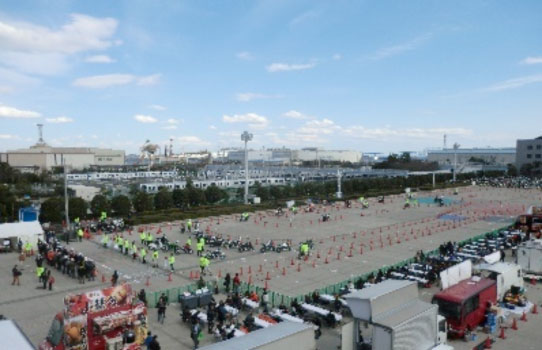This year’s show featured participation by a total of 121 companies and 13 organizations. That included 28 motorcycle-related producers (among them the four JAMA member motorcycle manufacturers) and one organization, 81 parts and accessory suppliers, 12 publishers and 12 groups involved in motorcycle safety, recycling and other related activities. With a total of 112 booths set up for displays and events, the gathering emerged as the largest motorcycle show to ever be staged domestically in Japan.
The Tokyo Motorcycle Show is an annual affair held each March with the purpose of expanding the overall market for motorcycles and stimulating new product demand. The gate surpassed the 100,000-visitor milestone for the first time in 2012, with last year’s show drawing 132,249 persons. The 43rd version was also a solid success, with attendance slightly bettering last year’s previous peak at a new record high of 132,575 persons. The same basic motorcycle festival was also staged in Osaka, with this year’s show also setting a new attendance record with 62,512 visitors on hand.
Immediately catching the eye upon entering the Tokyo Big Sight hall was a booth sponsored by the Metropolitan Police Department, highlighted by a number of motorcycle police and their machines. These motorcycling professionals provided tips on safe driving to avoid accidents, the importance of properly fastening helmet chin straps and wearing protective gear, information about “Safety Rider Contest 2016” and other pointers and appeals for motorcycle safety.
Not far from that were the booths of the various motorcycle industry organizations, which were used to provide explanations of Japan’s motorcycle recycling system, collect signatures for a petition aimed at supporting improvements in the motorcycle use environment and other activities.
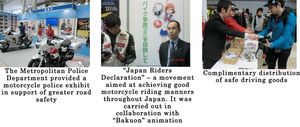

Moving past that area led to booths of motorcycle parts and accessory suppliers and vehicle manufacturers.

Next, we profile the show booths sponsored by the four JAMA member motorcycle manufacturers.
Honda Motor
The Honda booth, featuring displays of 14 models in all, was utilized for the global unveiling of the “Concept CB Type II” – a concept model proposing a new direction for the air-cooled “CB Series.” Differing from the traditional image of the “Concept CB” exhibited at the Tokyo Motor Show last fall, the “Concept CB Type II” breaks ground on a new air-cooled CB concept stressing a sports presence.
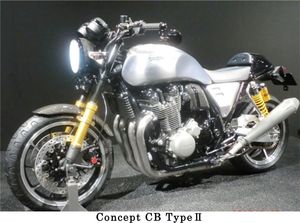
Among the other Honda machines on display was the “CRF1000L Africa Twin,” only recently released on the market, which many booth visitors climbed aboard for a direct feel. Also attracting keen attention here was the “Africa Twin Adventure Sports Concept” – a model steeped in the image of sheer adventure. This motorcycle is engineered along the lines of the “CRF1000L Africa Twin,” in striving to address the keynote concept of “Going anywhere you like.”

Honda also took advantage of this occasion to showcase the “CRF450 RALLY” motorcycle that performed so well at the Dakar Rally; the “CRF250 RALLY Prototype” based on the on-off-road “CRF250L” and rich in the “CRF450 RALLY” image; the concept model “City Adventure Concept” infusing the spirit of adventure into urban motorcycling and other models positioned to drive home a pronounced sense of adventure.
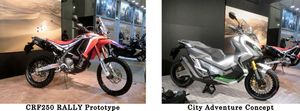
Kawasaki Motors
The Kawasaki booth was designed with a major focus on celebrating the victory of rider Jonathan Rea at the 2015 World Superbike Championship (WSB). Led by the “New Ninja ZX-10R,” the lime-green Ninja Series was featured at the hub of the booth, with 12 different models displayed in all.

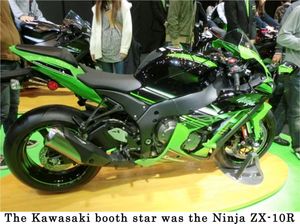
Other big crowd draws were the “Z125 PRO” small displacement model (also appointed in the same lovely lime-green hue), along with the “Z250SL” naked model. Both of these machines have only just recently been released on the marketplace, inspiring a steady stream of young motorcycle buffs to straddle their saddles to get a direct sense of the riding position and other finer points.
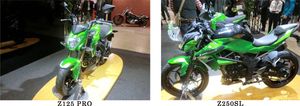
Yet another Kawasaki pleaser was the 200hp supercharger mounted “Ninja H2” model, currently marketed under the formidable nickname of “Ultimate Ninja.”

Suzuki Motor
The Suzuki booth exhibited a total of 19 models (7 reference concept models and 12 production models). The displays consisted of the “SV650 ABS” new overseas model, the “GSX-R1000” concept model being introduced for the first time in Japan and other attractive models. Suzuki booth staffers explained that the key features of the SV650 ABS are its slim body, firm rider footing and other outstanding traits supporting the caliber of light and nimble riding that only a V twin engine can deliver.
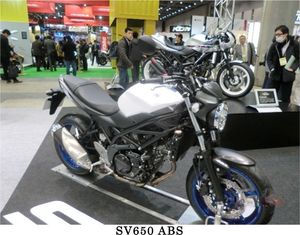
The booth staffers reported that the GSX-R1000 was developed with the mission of realizing the world’s No. 1 sports motorcycle.
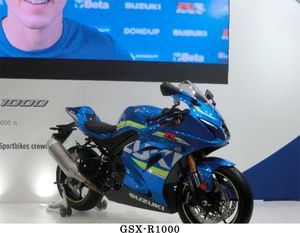
The “GSX-RR” MotoGP machine was on exhibit here, with visitors able to mount up in a full bank position to savor the ambience of actually taking to a race circuit. Also displayed was the “R-Z450WS” All-Japan Motocross champion machine (IA-1), along with 12 production unit models (mainly large displacement sport models) such as the Hayabusa.
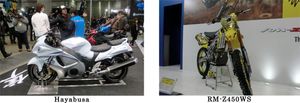
Yamaha Motor
The booth prepared by Yamaha, which last year celebrated the 60th anniversary of its founding, deployed a lineup of 30 vehicles ranging from practical utility to sports models. The featured machine was the “XSR900,” making its first-ever Japan introduction. This motorcycle deserves admiration as a genuine road star based on the fusion of retro exterior looks and cutting-edge technology driven performance. According to the booth staff members, the model is also designed for easy customization.
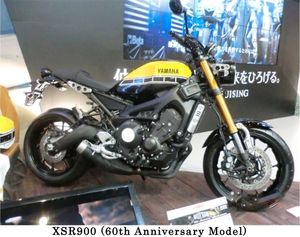
Moving further around the booth, Yamaha also took advantage of this venue to display the “MT Series,” “BOLT Series,” “YZF-R Series” and “MAX Series,” along with the “LMW (Leaning Multi-Wheel)” new mobility model with two front wheels. While the “TRICITY 125” is already on sale, the “TRICITY 155” was revealed for the first time at this show. This latest addition is a model that can also be used on Japan’s expressways (where motorcycles 125cc and below in displacement are banned).
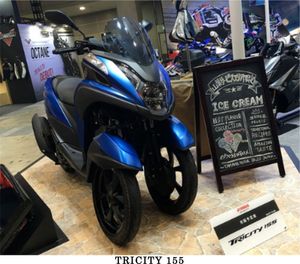
Earning key notice from visitors to the Yamaha 60th Anniversary Corner was the famed “YZR 500” racing machine from years gone by, as well as the “R25” 250cc sports model.
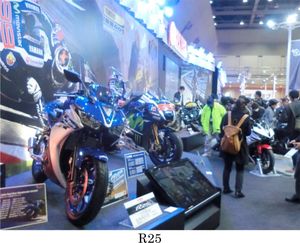
This year’s Tokyo Motorcycle Show also included passionate participation by a large number of overseas manufacturers.
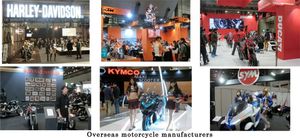
Test Rides
Areas outside the Big Sight show venue were utilized for test-ride sessions. As long as visitors held the proper license, it was possible to take not only the new 2016 models for test spins, but also experience the feel of upscale machines priced beyond the reach of most riders. Signups for test rides were accepted from 1:10 p.m. on March 25, with long lines forming at once and riding slots for the most popular models filling up in no time at all.


Parent-Child Motorbike Experience Test Rides
Held right alongside the test ride area were “Parent-Child Bike Experience Test Rides.” Participation for kids and guardians was free of charge, and open to those age 5 and older basically capable of riding a bicycle. The children were loaned a helmet, elbow and kneepads, a body protector and gloves, and then rode around on miniature-size “pocket motorbikes” under the instructions of supervisors.

In addition to such displays and opportunities, show events included a dynamic riding demonstration by a ladies motorcycle police team from the Metropolitan Police Department, a “trial demonstration” by international A level super class riders, a talk show program broadcast on the BS11 satellite channel devoted to motorcycles and other attractions.
Over the years, large numbers of motorcycle aficionados have driven their own machines to the Tokyo Motorcycle Show. This latest event was forecast to be no exception, with the sponsors preparing three separate motorcycle reserved parking lots near the site. Despite such efforts, however, the first day saw all of those lots full soon after the gates opened.

